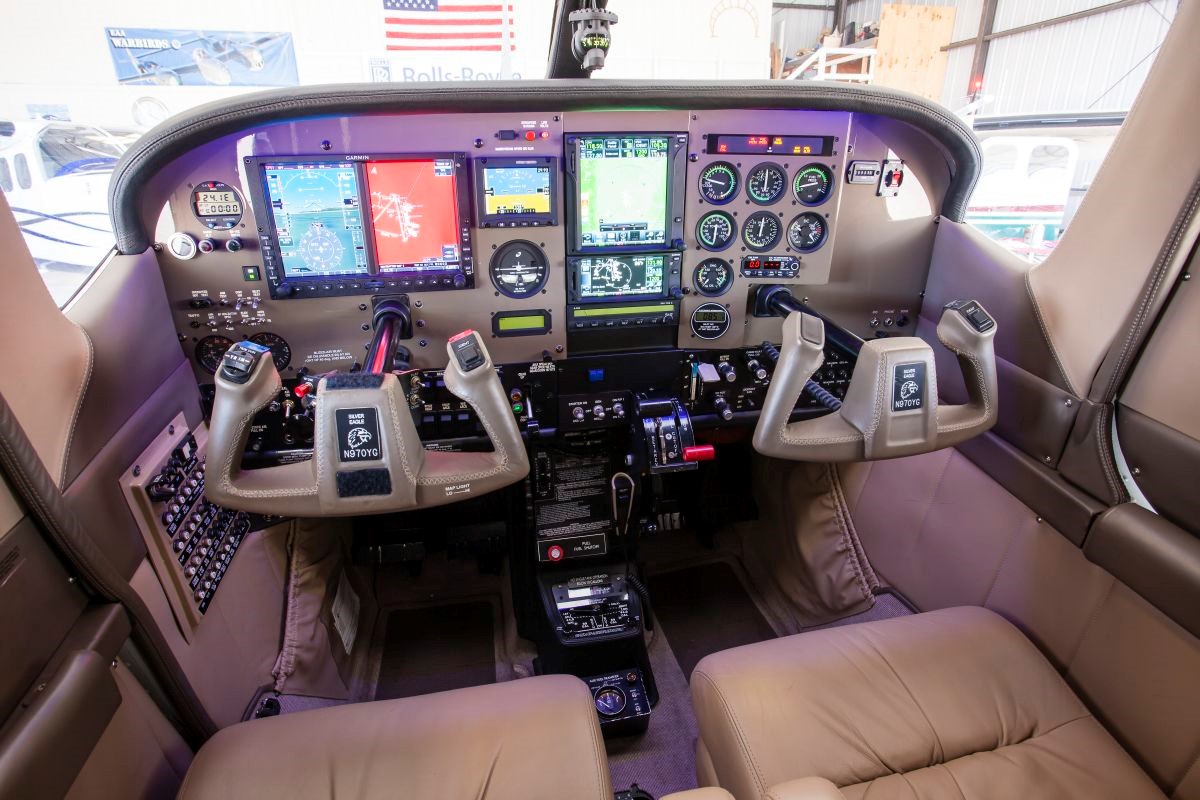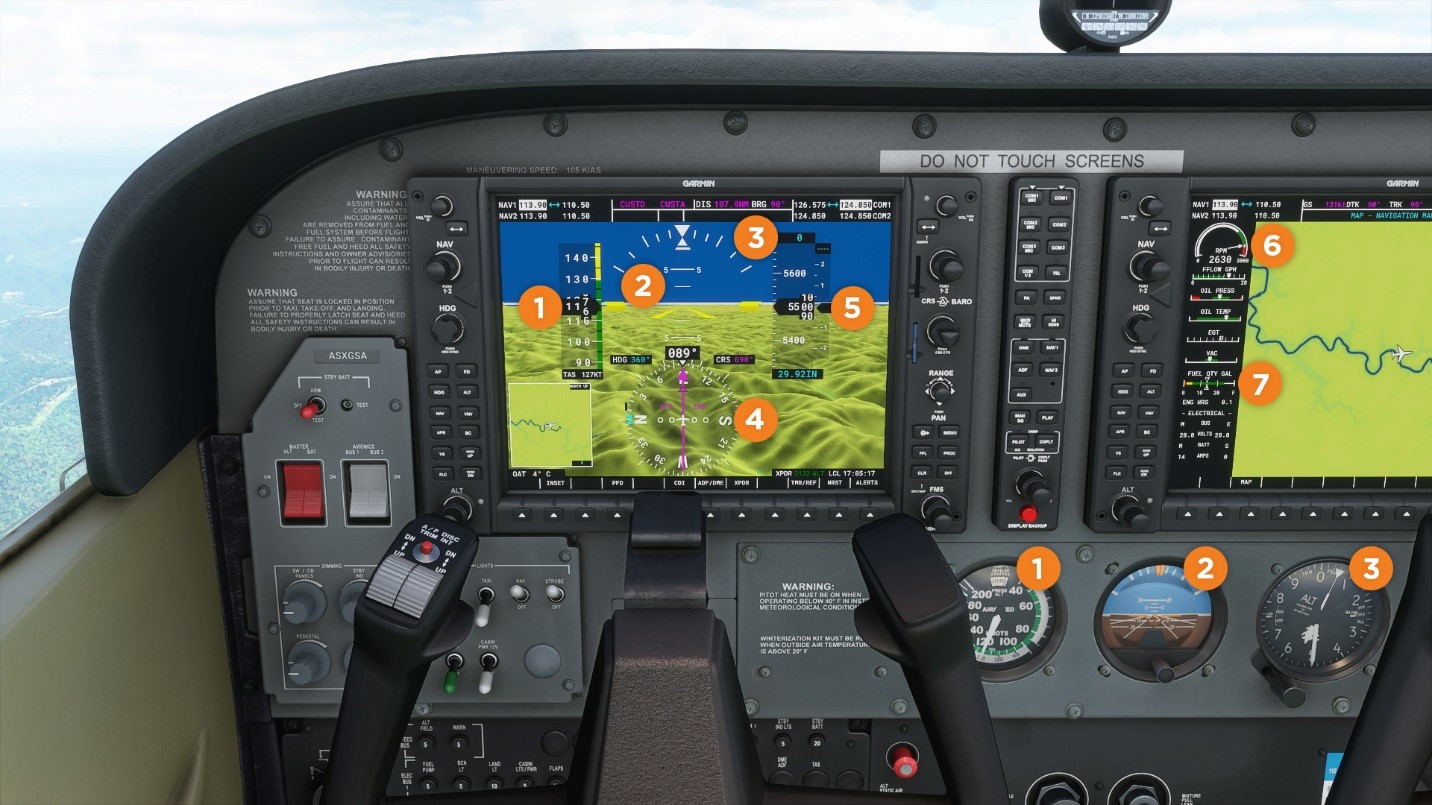Flight Deck Controls
Safety Spotlight: Pinch Hitter

Instrumentation may consist of several individual gauges, which are often called steam gauges, or may be shown together on digital displays as part of a “glass cockpit.” The instruments show a variety of information—from airspeed and altitude to your location and engine temperature. Be sure to ask your pilot to explain the types of instruments in the airplane you fly.

- Airspeed Indicator: The airspeed indicator is like the speedometer in your car. (Reads: 122 knots)
- Attitude Indicator: The attitude indicator, sometimes called an artificial horizon, shows the airplane’s pitch and bank in relation to the horizon. (Shows level flight)
- Altimeter: The altimeter shows the aircraft’s height above mean sea level (msl). (Reads: 3,000 feet msl)
- Heading Indicator: The heading indicator shows the direction the aircraft is flying. (Reads: 150 degrees)
- Vertical Speed Indicator: The vertical speed indicator (VSI) shows the rate in feet per minute that the aircraft is going up or down. For most airplanes, a comfortable rate of climb or descent is between 500 and 1,000 feet per minute. (Reads: 0 fpm descent)
- Tachometer: The tachometer indicates how much power the engine is producing. (Reads: 2600 rpm)
- Fuel Gauges: Most general aviation aircraft have one fuel tank in each wing, but your airplane may have more. This gauge shows how much fuel is in each tank. (Reads: 11 gallons (left tank) 12 gallons (right tank))

- Airspeed Indictor: The airspeed indicator is like the speedometer in your car. (Reads: 116 to 117 knots)
- Attitude Indicator: The attitude indicator, sometimes called an artificial horizon, shows the airplane’s pitch and bank in relation to the horizon. (Shows level flight)
- Altimeter: The altimeter shows the aircraft’s height above mean sea level (msl). (Reads: 5,500 feet msl)
- Heading Indicator: The heading indicator shows the direction the aircraft is flying. (Reads: 89 degrees)
- Vertical Speed Indicator: The vertical speed indicator (VSI) shows the rate in feet per minute that the aircraft is going up or down. (Reads: 0 feet per minute)
- Tachometer: The tachometer indicates how much power the engine is producing. (Reads: 2630 rpm)
- Fuel Gauges: Most general aviation aircraft have one fuel tank in each wing, but your airplane may have more. This gauge shows how much fuel is in each tank. (Reads: Approximately 13 gallons in both the left and right tanks)
Radio and Transponder
There are two main components to communications with ATC and other airplanes: the radio and the transponder.
When talking on the radio, simply say who you’re calling, who you are, and what you want. In an emergency, just speak normally.
Talking on the radio may be intimidating, but it’s no big deal. Next time you fly, ask your pilot to show you the basics of operating the radios. Depending on where you are and how comfortable you feel, you can even ask to make a call or two!
Everyone has to take turns when speaking on the radio. If two or more pilots try to talk at the same time, both transmissions will be ‘blocked’ and not heard.
When talking on the radio, simply say who you’re calling, who you are, and what you want. In an emergency, just speak normally. If not already talking to someone on the radio, use the standard emergency frequency of 121.5.
The transponder sends a code to air traffic control’s radar, and now ADS-B (a ground-based system to aid in air traffic separation) allows equipped airplanes to view your radar signal as well. Two codes worth knowing are 1200 (normal VFR operations) and 7700 (emergency). Ask your pilot if you can put in the transponder code next time you fly!
Four Ws of Communication
Do you know what to say before keying the mic? The AOPA Air Safety Institute’s Safety Tip: Four Ws of Communication will help hone your radio skills. Whether you’re flying at a nontowered field or communicating with ATC, concise communication improves safety.